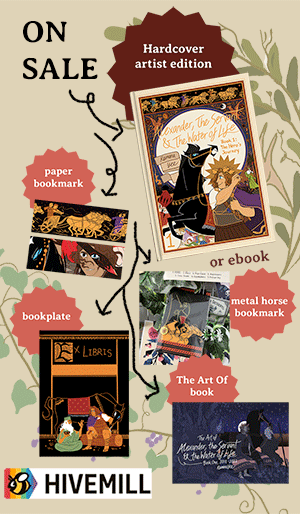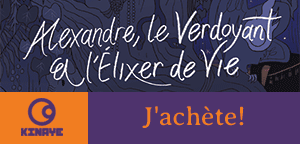Writing
Now this is where the REAL work began. Beyond a few one-shot experiments, I hadn't actually drawn Alexander or the Servant acting as characters in service of the narrative. So it was fun and exciting to do that, to realise the story as I had imagined it (more or less) in my head during script-writing.Chapter One is made to complement and contrast slightly with the Prologue; introduce my voice and my art style in their purest state; and establish this version of the Alexander Romance as entirely original (in the sense that it's mine). Unlike the Prologue, there is little to no intertextual allusion. Accordingly, Alexander's appearance doesn't shapeshift, since narratively and visually, I'm introducing his primary face to the reader (which I call "the Lysippos face"), an invention of my own design based on research and a combination of several references.
-
The writing of this chapter (and the rest of Alexander Comic) is very new to me. Rather than the standard way of approaching comics as a script, or sometimes, as prose squeezing itself into a visual medium – I'm trying this thing where I am approaching it as poetry,
which values economy of words and precision of
feeling/meaning/impact/imagery.
There’s this idea I have that comics writing is more akin to poetry than prose, since speech bubbles are already evoking actual speech (pauses, tone, emphasis, etc), and when bubbles are separated, the separation acts as caesura or enjambment.
What if I take this idea as far as I can go?
How do I combine the poetry of the written word with the poetry of the visual in a way that feels inseparable?
Especially in a way that only comics can do, with its ability to manipulate time by spatial relation. (basically, the closer two panels or bubbles are in the space they share, the closer they are in time. The opposite is also true)
Poetry has already experimented with how white space can change rhythm and meaning, which is exactly what I have done with the dialogue. The added spice is that I am also using panel arrangement and all of the other graphic literary devices to serve the same function. The most obvious example is on Page 25 - 26, when Alexander is talking about the omens:
"Not too long ago,
(enjambment, then the following line on the next panel/page)
I received an omen.
Many, in fact.
(three panels)
I'm to die soon.
(following panel)
Right here.
(end stop, with the reader turning the page)
In Babylon."
I am looking forward to more experiments in this area, especially when I get to the silent scenes, when images become the only linguistic device for meaning.
Thumbnailing and Sketching
Tools
Thumbnails: Moleskine notebook, mechanical pencil
Sketches: Procreate, iPad with Apple pencil
Time taken
Thumbnails: Under an hour.
Sketches: (not counting breaks) 9 hours. In real time, two or three days.
Inking and Colouring
Tools
Inks: Huion H610 Pro, Huion Kamvas Pro, Photoshop
Colours and Letters: Photoshop
Time taken
Inks: A week of intermittent work, starting from June 30th to July 9th. I was juggling both completing my other graphic novel and getting used to the new drawing tablet, which has a glassy surface texture and a retina screen that my outdated senses found disorienting. (I'm adapting alright now)
Colours: Another week of intermittent work, from July 9th to 18th. I finished colouring the last 8 pages (4 spreads) within a day. The one that took the most time was the banquet spread.
Research
In the Prologue Author Notes I mentioned the place-setting I had to do for this chapter. Place-setting was pretty much the entirety of the research this time. I had to design the interiors/exteriors of buildings, place appropriate props and dress characters accordingly. Fortunately it's still small-scale, on easy mode – I only had to expend most of my brainpower for the one room (the banquet). In the next chapter, I have to draw the outside of Babylon...-
As for Alexander's clothes, I did the work for it ages ago. I originally began from this concept drawing, which was my first take on the first time he wore a hybrid Macedon-Persian outfit. The fashion snob inside me couldn't stand it though – it didn't look like something a king (or an actual person) would wear, especially with the Macedonian flat cap. So I did another pass (drawing below), which had more thorough research on the visual motifs of Achaemenid art and several design alternatives.

Caption: 6 fashion design drawings of Alexander in his royal Persian outfit, accompanied by notes and stock Achaemenid motifs.
Alexander's Persian outfit was a a purple chiton with a white middle, accessorised with a sash, diadem and staff. Pretty vague. A lot of possibilities are hidden within this description – many ways to pleat a skirt, tie a sash, decorate a hem – just as there are many shades of purple.
Some people would choose to give Alexander long sleeves up to his wrist, but not me. I decided to go with the long skirt down to his ankles.
This chapter will be the only time in Book One where we will see Alexander in this style of dress.
-
The piece that begins this chapter comes from another Alexander Romance author, Nizami Ganjavi, who I have referenced in the Prologue as an influence. It's taken directly from the prologue of his own Alexander Romance poetic epic, the Sikandar Nama e Bara.
The epic was translated into the only English edition in the late 19th century, but given its super literal translation, the whole thing is a bit of a doozy to read. Here is the original English passage by which the quote comes from:
(of Sikandar’s life) many the events that formerly (long ago) passed. --
Them, I make living by my own water of life (lustrous verse).
Sikandar, — who took the path of truth (spirituality),
Tracked out the fountain of life (the water of immortality):
Wandered, so that by the path of good fortune,
He might, by the fountain of life, becoming living:
Sought the road to the fountain of life (the poet’s lustrous verse),
— Found now that fountain, which then he (vainly) sought.
My
consultant Richard Stoneman recommended I give a go at reinterpreting
the passage – which was a bit worrying since I couldn't read the original
Persian text hahahaha (obviously he can). So we had a brief
conversation about creating a more accessible translation, and I came
away with a draft, then revised it so that I merged the two sections of
that verse into a single story. (The first section is Nizami stating the
takeaway message of the second section, which is the actual poem)





